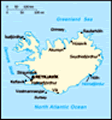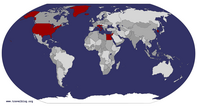Advertisement
Published: August 30th 2019
Now we are in North Iceland and our weather is acceptable - sporatic rain but not clear either. We left Egilsstair and traveled the Highlands to an isolated farm. The man who lives here was so far away from a church that he built his own church. He has turned his farm into accommodations, camping, cafe, gift shop, and a cute tourist stop. Sindri, our guide, said there was an arctic fox and he could call him from his burrow, because Sindri speaks fox saying he learned from a girlfriend who was foxy (Sindri is quite the jokester). Sure enough, Sindri called him and a young arctic fox comes out of the burrow where he sleeps.
From here we went to Dettifoss.
From Wikipedia:
Dettifoss is a
waterfall in
Vatnajökull National Park in Northeast
Iceland, and is reputed to be the most powerful waterfall in
Europe. Dettifoss is situated on the
Jökulsá á Fjöllum river, which flows from the
Vatnajökull glacier and collects water from a large area in Northeast Iceland. The sediment-rich runoff colors the water a greyish white.
The falls are 100 metres (330 ft) wide and have a drop of 44 metres (144 ft) down to the Jökulsárgljúfur
canyon. It is the largest
waterfall in Iceland in terms of volume discharge, having an average water flow of 193 m³/
s. The superlative of "most powerful" comes from its water flow times its fall distance. The water of the wide
Jökulsá á Fjöllum river falls for more than 44 metres.
I got quite wet here. The wind takes the spray from the waterfall and spreads it over the viewing area. The power of this waterfall was incredible.
From here we drove to Nmaskar geothermal area, with fumaroles and mud pots. Supposedly scenes from Game of Thrones were filmed here. They used to mine sulphur back when there was a market for it. The Mid Atlantic Ridge goes through this area and the North American Plate and European Plate are spreading in this area, hence lots of geothermal activity.
Next stop was the Myvatn Nature Baths the highlight for me today. As a note of interest, there is a huge thermal bath sorta near Reykjavik (40 minute bus ride), the Blue Lagoon, which cost close to $60 U.S. The lagoon is man-made. The water is a byproduct from the nearby
geothermal power plant
Svartsengi where superheated water is vented from the ground near
a lava flow and used to run
turbines that generate electricity. After going through the turbines, the steam and hot water passes through a
heat exchanger to provide heat for a municipal water heating system. Then the water is fed into the lagoon.
This thermal bath draws geothermal water from a borehole and is rich in minerals, silicates and geothermal micro-organisms (that's what the sign says). It cost about $36 U.S. Most of our group went in. They give you a coin for a locker, you get one that has a key in it, drop the coin, put your clothes in the locker, take a shower, get your bathing suit on and enjoy the thermal bath. You can get beer served to you while in the bath. Best part of the day.
The thermal baths are near Lake Myvatn. The lake is famous for the millions of midges (like mosquitoes) that are here. Because of the midges, there are alot of birds here.
Mývatn is a shallow
lake situated in an area of active volcanism in the north of
Iceland, not far from
Krafla volcano. It has a high amount of
biological activity. By the lake and
the surrounding
wetlands there is a variety of
waterbirds, especially
ducks.
The lake was created by a large
basaltic lava eruption 2300 years ago, and the surrounding landscape is dominated by volcanic landforms, including
lava pillars and
rootless vents (
pseudocraters). The effluent river Laxá is known for its rich fishing for
brown trout and
Atlantic salmon.
The name of the lake (
Icelandic mý ("
midge") and
vatn ("lake"); the lake of midges) comes from the huge numbers of midges to be found there in the summer.
The lake is fed by
nutrient-rich springwater and has a high abundance of aquatic insects (
Chironomidae) and
Cladocera that form an attractive food supply for ducks. Thirteen species of ducks nest here. The duck species composition is unique in the mixture of Eurasian and North American elements and of
boreal and
arctic species. Most of the ducks are migratory, arriving in late April – early May from north-western Europe. The most abundant is the
tufted duck, which immigrated to Iceland at the end of the 19th century. The
greater scaup is the second most common duck species.
Other common species include the
Barrow's goldeneye,
red-breasted merganser,
wigeon,
gadwall,
mallard,
common scoter,
long-tailed duck and
Eurasian teal. The outflowing Laxá river has a
dense colony of
harlequin ducks and there is a large colony of
eiders at the river mouth some 50 km away from Lake Mývatn. The Barrow's goldeneye is special in being the only
nearctic duck in the area (and Iceland as a whole). Its population of about 2000 birds relies entirely on the habitat provided by the Mývatn-Laxá water system and its surrounding lava fields. Most of the Barrow's goldeneyes overwinter there, using ice-free areas kept open by emerging spring water (both warm and cold) and in the strong river current. This species is a hole-nester, in North America using tree-holes, but at Mývatn the birds use cavities in the lava for nesting. The other duck species nest abundantly in the numerous islands of the lake and the surrounding marshlands.
Other common waterbirds include the
Slavonian grebe,
red-necked phalarope,
great northern diver,
red-throated diver and
whooper swan.
Next we went to Dimmuborgir. The Dimmuborgir area consists of a massive, collapsed
lava tube formed by a
lava lake flowing in from a large
eruption in the Þrengslaborgir and Lúdentsborgir crater row to the East, about 2300 years ago.
At Dimmuborgir, the lava pooled over a small lake. As the lava flowed across the wet sod,
the water of the marsh started to boil, the vapour rising through the lava forming
lava pillars from drainpipe size up to several meters in diameter.
As the lava continued flowing towards lower ground in the
Mývatn area, the top crust collapsed, but the hollow pillars of solidified lava remained. The lava lake must have been at least 10 meters deep, as estimated by the tallest structures still standing.
In Icelandic folklore, Dimmuborgir is said to connect earth with the infernal regions. In Nordic
Christian lore, it is also said that Dimmuborgir is the place where
Satan landed when he was cast from the heavens and created the apparent "Helvetes katakomber" which is
Norwegian for "The Catacombs of Hell".
Dimmuborgir was used as a shooting location for HBOs fantasy tv-series Game of Thrones. Dimmuborgir forms the background of Mance Rayders wildling camp.
The Norwegian
symphonic black metal band
Dimmu Borgir is named after the Dimmuborgir region.
Next stop: Godafoss. Are you tired of waterfalls yet? There are zillions of waterfalls in Iceland and we are going to the main attractions.
The
Goðafoss (
Icelandic: "waterfall of the gods" or "waterfall of the
goði") is a
waterfall in
Iceland. It
is located in the
Bárðardalur district of
Northeastern Region at the beginning of the
Sprengisandur highland road. The water of the river
Skjálfandafljót falls from a height of 12 metres over a width of 30 metres.
The river has its origin deep in the Icelandic highland and runs from the highland through the Bárðardalur valley, from Sprengisandur in the Highlands.
In the year 999 or 1000 the
lawspeaker Þorgeir Ljósvetningagoði made
Christianity the official religion of Iceland. According to a modern myth, it is said that upon returning from the
Alþingi, Þorgeir threw his statues of the Norse gods into the waterfall.
3%!B(MISSING)0afoss_aerial_pano_2017.jpg/500px-1_Go%!C(MISSING)3%!B(MISSING)0afoss_aerial_pano_2017.jpg)
We drove to Akureyri and had dinner there. This town is the largest town in Northern Iceland, with a population of 18,00 and is nicknamed the capital of North Iceland. Cruise ships stop here so there's a decent harbor here. It is located at the inland end of the Eyjafjrur fjord. Because of the town's position at the head of a long fjord surrounded by high mountains, the climate is more typically inland than coastal, with greater variations in temperature (warmer summers, colder winters) than in many other inhabited parts of Iceland. However, the
mountains shield the town from strong winds. The relatively warm climate (for its latitude) allows the botanical gardens to flourish without need of a greenhouse.
The area around Akureyri has one of the warmest climates in Iceland, even though it is only 100 km (62 mi) from the Arctic Circle.
We continued to Dalvik for our hotel and the staging area for our whale watching trip tomorrow.
I have not told much about the countryside inbetween all these beautiful stops we make. The countryside is mostly farming: mostly sheep, some cattle, horses. It's a beautiful peaceful place to drive through. There are more sheep here than people. Also, fishing is a huge industry here. Back in the 1600's to 1900's fishing was mostly done just to provide for your family and neighbors. There were fishing fleets from France and England that were depleting the fish stock. Wikipedia explains it better than I can: The Cod Wars:
The
Cod Wars (
Icelandic: Þorskastríðin, "the cod wars", or
Landhelgisstríðin, "the wars for the territorial waters") were a series of confrontations between the
United Kingdom and
Iceland on
fishing rights in the
North Atlantic. Each of the disputes ended with an
Icelandic victory.
The Third Cod War concluded in 1976, with a highly favourable agreement for Iceland; the United Kingdom conceded to a 200-nautical-mile (370-kilometre) Icelandic exclusive fishery zone after threats that Iceland would withdraw from
NATO, which would have forfeited NATO's access to most of the
GIUK gap, a critical
anti-submarine warfare chokepoint during the
Cold War.
As a result, British fishing communities lost access to rich areas and were devastated, with thousands of jobs lost.
Since 1982, a 200-nautical-mile (370-kilometre)
exclusive economic zone has been the
United Nations standard.
The term "cod war" was coined by a British journalist in early September 1958.
None of the Cod Wars met any of the common thresholds for a conventional
war, and they may more accurately be described as
militarised interstate disputes.
There is only one confirmed death during the Cod Wars: an Icelandic engineer, who was accidentally killed in the Second Cod War while he was repairing damage on the Icelandic gunboat
Ægir after a collision with the British frigate
Apollo. They collided again, on 29 August 1973.
There's a long discussion in Wikipedia about the
Cod Wars if you are interested. The richness of the fishing off Iceland comes from the continental shelf and the currents, like the Gulf Stream, that keep the waters at a certain temperature.
Iceland is a magical place. I'm learning so much while I'm here.
Advertisement
Tot: 0.13s; Tpl: 0.018s; cc: 10; qc: 31; dbt: 0.0448s; 1; m:domysql w:travelblog (10.17.0.13); sld: 1;
; mem: 1.2mb







3%!B(MISSING)0afoss_aerial_pano_2017.jpg/500px-1_Go%!C(MISSING)3%!B(MISSING)0afoss_aerial_pano_2017.jpg)


 Maroon
Maroon 












